How to Price Resold Organic Cakes for Maximum Profit
To price resold organic cakes for maximum profit, start by evaluating your ingredient costs and labour efficiency. Consider market demand, paying attention to seasonal trends and what consumers want in healthier options.
Use competitive pricing strategies like tiered offerings and bundles to appeal to different budgets. For example, you might offer a single slice, a small cake, or a larger celebration cake at varying price points.
Apply psychological pricing techniques to enhance perceived value; pricing at £14.99 instead of £15 can make a difference. Highlight your quality sourcing and sustainable practices to justify premium prices. With these strategies, you can optimise your approach for better profitability.
Key Takeaways
- Calculate your total costs, including sourcing organic ingredients, labour, and overheads, to set a solid pricing base for your resold organic cakes.
- Review competitors' pricing strategies to position your cakes effectively, highlighting their premium quality.
- Implement tiered pricing to accommodate different customer budgets, offering basic, premium, and luxury cake options.
- Use psychological pricing techniques, such as charm pricing (e.g., £19.99 instead of £20) and price anchoring, to enhance perceived value and boost sales.
- Emphasise the benefits of organic ingredients and sustainable practices to justify higher prices and attract health-conscious customers.
Understanding Cost Components for Organic Cakes

When pricing your resold organic cakes, it's crucial to understand the cost components to set a competitive and profitable price.
Start by evaluating ingredient sourcing; organic ingredients often come at a premium, so accurately calculate the cost per unit. For instance, using organic unbleached flour and homemade brown sugar in a rainbow carrot cake can significantly affect your costs. Additionally, sourcing certified organic ingredients ensures quality and supports sustainable practices, which can appeal to health-conscious consumers.
Next, consider labour efficiency. Estimate the time required for each cake, especially for intricate designs, as this directly influences labour costs. Valuing time is essential for accurate pricing, as the time spent on cake creation should be compensated.
Keep track of the time spent on orders to improve your estimates. By combining precise ingredient and labour cost assessments with overhead calculations, you can create a pricing strategy that reflects both quality and profitability.
Analyzing Market Demand and Seasonal Trends
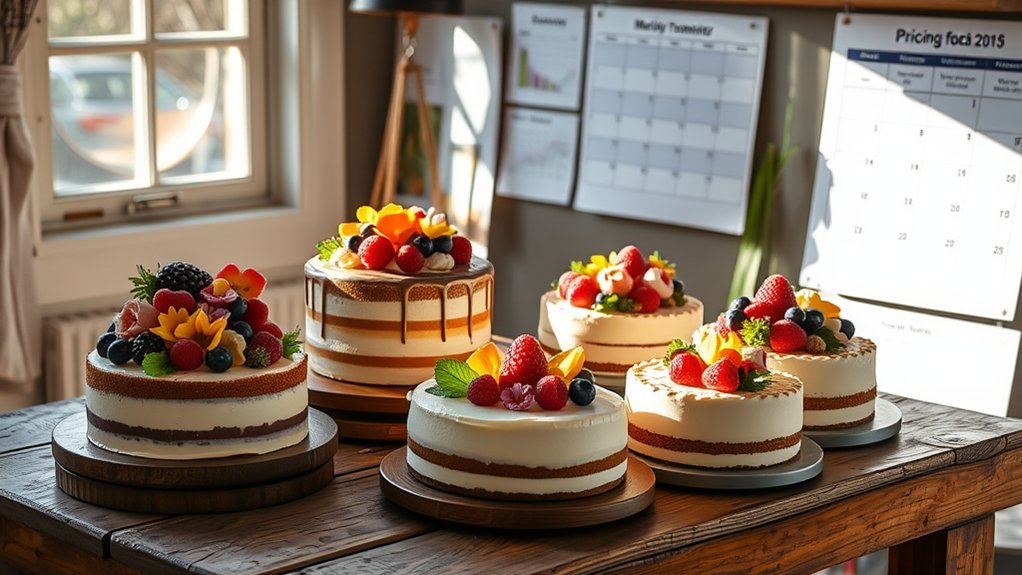
Market demand for organic cakes in the UK is shaped by various factors, notably consumer preferences and seasonal trends.
As more people lean towards healthier options, there's an increasing desire for organic cakes, particularly those without artificial additives. Seasonal flavours, such as pumpkin in autumn or refreshing citrus in summer, can lead to noticeable spikes in demand. Additionally, the U.S. organic cake market is projected to grow at a CAGR of 8.5%, reflecting a broader trend that could positively influence the UK market as well. The shift towards organic ingredients not only caters to health-conscious consumers but also supports sustainable practices, enhancing the appeal of your products.
During holidays and special occasions, consumers often seek out unique, healthier cake alternatives, which can enhance your sales opportunities.
It's also wise to offer gluten-free and vegan options to appeal to specific customer segments.
Staying attuned to these trends and adjusting your product range accordingly—especially during peak seasons—will help you effectively position your organic cakes in this growing market.
Competitive Pricing Strategies for Organic Products
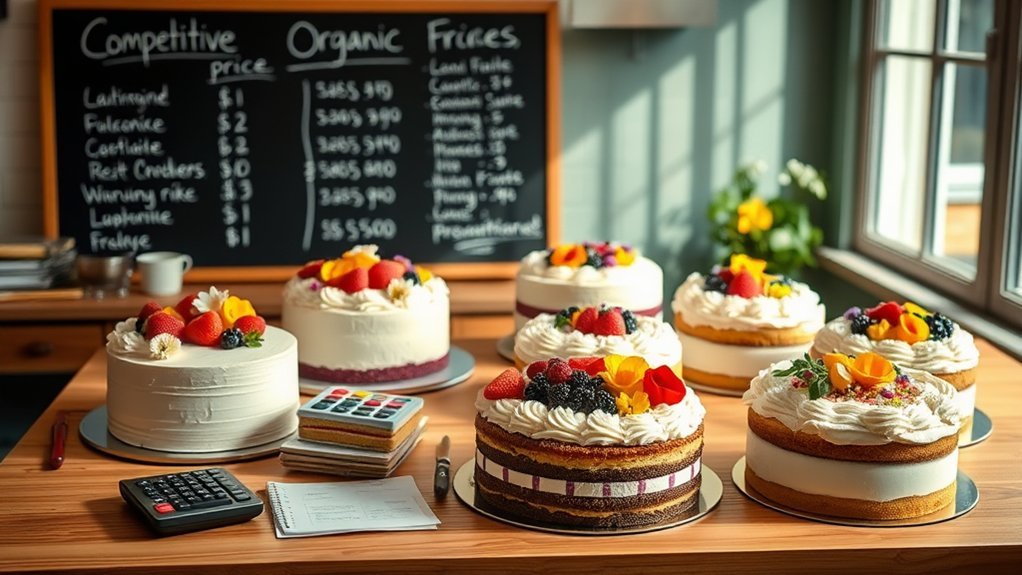
How do you choose the right pricing strategy for your organic cakes in a competitive market?
Start by analysing your competitors to see how similar products are priced. Identify key players, both local and national, and understand their pricing strategies.
You might consider value-based pricing, as customers often view organic cakes as premium quality, which allows for higher pricing. However, keep an eye on your production costs and competitors' prices to maintain your market position. Understanding the competitive perimeter can help you position your pricing strategy effectively. Additionally, emphasizing the benefits of using organic ingredients can further justify your pricing by highlighting their nutritional advantages.
Emphasise unique features, such as locally sourced ingredients or ethical practices, to justify higher prices.
Regular market analysis is crucial; staying updated on consumer preferences will help you adjust your pricing effectively while ensuring profitability in this changing landscape.
Implementing Tiered and Bundle Pricing

Implementing tiered pricing for your organic cakes allows you to cater to different customer budgets while enhancing the perceived value with unique offerings at each level.
For instance, you could offer a basic cake at a lower price, a premium option with added decoration, and a luxury cake with bespoke flavours.
Additionally, effective bundle strategies can increase sales by pairing cakes with complementary items, such as coffee or pastries, appealing to customers who appreciate convenience and variety.
Advantages of Tiered Pricing
Many businesses face challenges with pricing strategies, but adopting tiered pricing for resold organic cakes can offer notable benefits. This method not only builds customer loyalty but also uses pricing psychology to enhance profitability.
Here are four key advantages:
- Profit Maximisation: By offering different product tiers, you can capture more value from customers.
- Customer Segmentation: This approach allows you to target various market segments, leading to increased satisfaction and loyalty.
- Upselling Opportunities: Clearly defined tiers encourage customers to upgrade, which can boost the average transaction value.
- Operational Efficiency: Improved demand forecasting aids in better resource allocation and inventory management.
For example, offering a basic, premium, and deluxe cake option can cater to different budgets and preferences, ensuring you reach a wider audience while maximising sales.
Effective Bundle Strategies
What strategies can you implement to create effective bundles for your resold organic cakes? Start by considering various bundle types, such as customizable options or seasonal themes, to appeal to different customer tastes.
You might include complementary products like biscuits or premium teas to enhance value.
Utilise tiered pricing models to offer bundles at different price points, making them accessible to a broader audience.
Keep an eye on competitors to set your offerings apart and adapt based on customer feedback.
Experiment with discounted pricing for larger bundles to ensure they're appealing while still being profitable.
Psychological Pricing Techniques
Creating effective bundles for resold organic cakes can significantly boost your sales strategy. By incorporating psychological pricing techniques, you can enhance perceived value and maximise profits.
- Price Anchoring: Start with a higher price for one option to make other bundles appear more appealing.
- Tiered Offerings: Provide different pricing levels to cater to diverse customers, increasing perceived value.
- Charm Pricing: Use prices like £9.99 to take advantage of left-digit bias, making items feel cheaper.
- Bundle Savings: Offer discounts for purchasing multiple cakes together, highlighting value and encouraging larger purchases.
These strategies can greatly impact buying decisions, making your organic cakes more attractive and profitable.
Utilizing Psychological Pricing Techniques
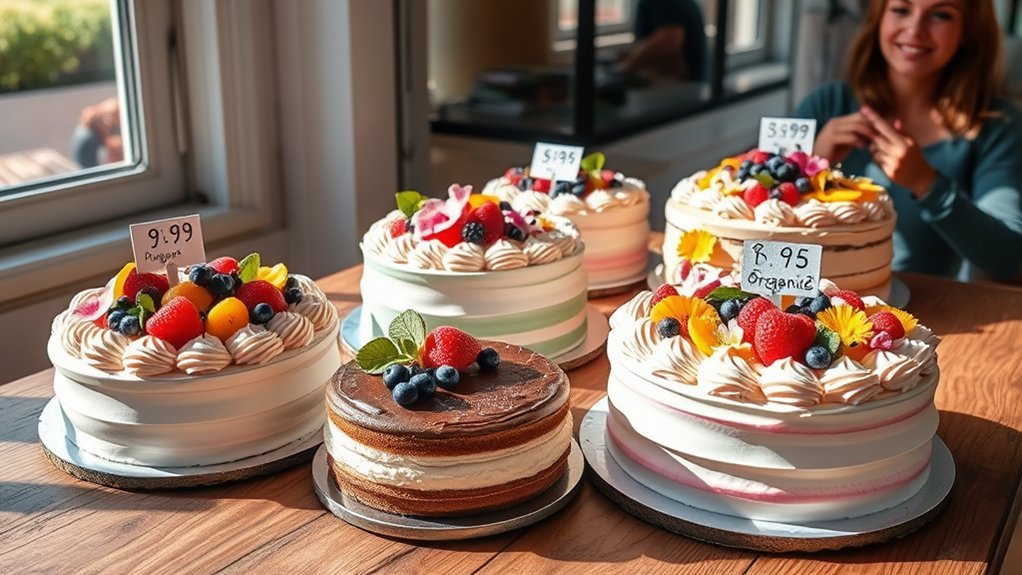
Using psychological pricing techniques can significantly boost your sales strategy by tapping into consumer behaviour.
Implement charm pricing by setting your organic cakes at prices ending in .99, such as £9.99. This simple adjustment can make your products seem more affordable, taking advantage of the "left-digit bias." You could see sales rise by as much as 24%.
Additionally, consider price anchoring by displaying a higher original price alongside your discounted price. This creates a perception of value and savings that consumers find attractive.
Just ensure that the original price is credible to maintain customer trust. By strategically applying these techniques, you can align your pricing with consumer psychology, ultimately enhancing your sales and profits.
Emphasizing Ingredient Sourcing and Quality
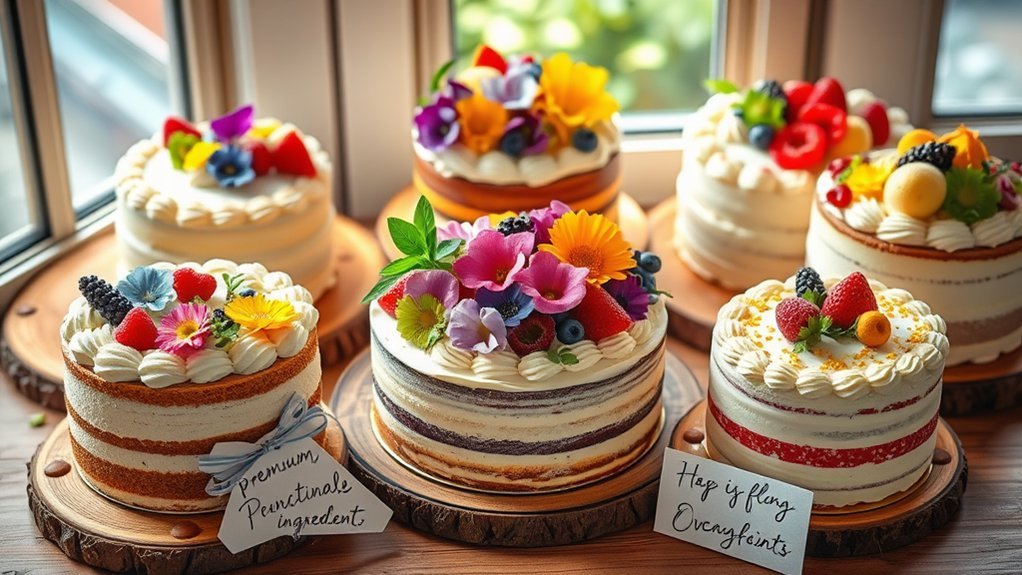
Emphasising sustainable sourcing and quality assurance not only enhances your product's appeal but also supports your pricing strategy.
Consumers in the UK are increasingly prioritising transparency and ethical sourcing, and they're often willing to pay more for cakes made with high-quality, locally sourced ingredients.
Sustainable Sourcing Practices
As consumers increasingly seek products that reflect their values, adopting sustainable sourcing practices for your organic cakes is crucial. Not only does this bolster your brand's reputation, but it also meets customer expectations.
Here are some straightforward strategies:
- Choose organic ingredients: Ensure your cakes are certified organic to appeal to discerning buyers.
- Partner with local suppliers: Sourcing locally helps reduce your carbon footprint and supports the local economy.
- Adopt fair trade practices: This ensures ethical sourcing and fair wages for farmers, enhancing your brand's credibility.
- Communicate transparently: Clearly share your sustainable practices with customers to foster trust and loyalty.
Quality Assurance Standards
To ensure your organic cakes meet high standards of quality and consumer expectations, it's vital to follow strict quality assurance practices.
Begin by obtaining certifications from USDA-accredited organisations, which demonstrate your commitment to ingredient integrity. Source your organic ingredients from suppliers who adhere to rigorous organic standards, ensuring they're free from synthetic pesticides and GMOs. This not only boosts nutritional value but also reinforces the authenticity of your cakes.
Keep detailed records of your sourcing and production methods, as these are essential for compliance during audits. By prioritising transparency and quality in your ingredient sourcing, you'll build consumer trust and maximise your profit potential while delivering outstanding organic cakes.
Leveraging Branding and Marketing for Value Perception
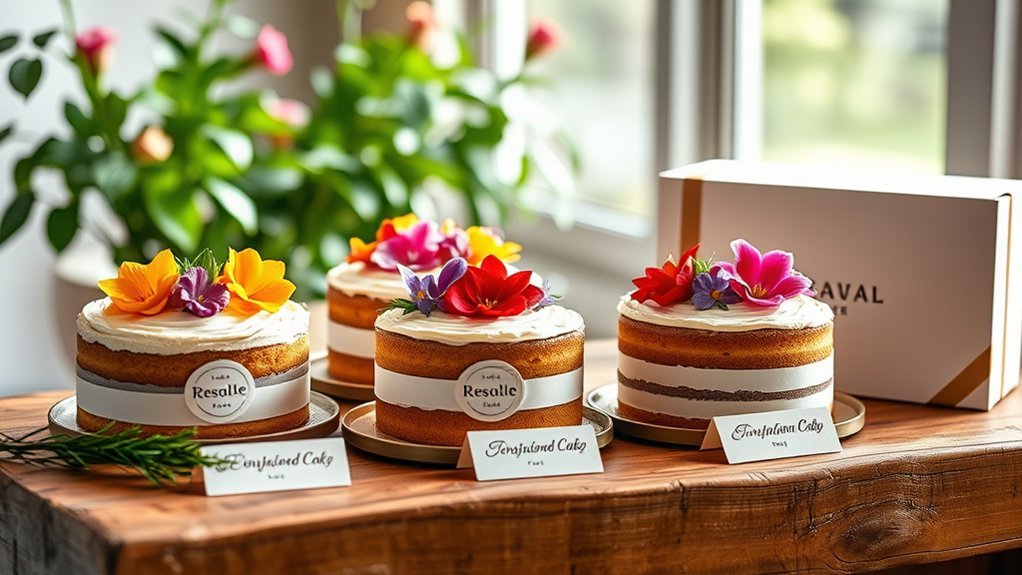
Branding and marketing are crucial for shaping how consumers perceive the value of organic cakes. To enhance your pricing strategy, consider the following:
- Brand Storytelling: Share the story behind your organic ingredients, highlighting their health benefits and sustainability.
- Consistent Branding: Use the same colours, fonts, and imagery across all platforms to build recognition and trust.
- Customer Engagement: Engage with your audience on social media, creating a community around shared values.
- Value-Based Pricing: Emphasise the premium quality of your cakes, justifying their higher prices compared to non-organic alternatives.
Exploring Distribution Channels for Wider Reach
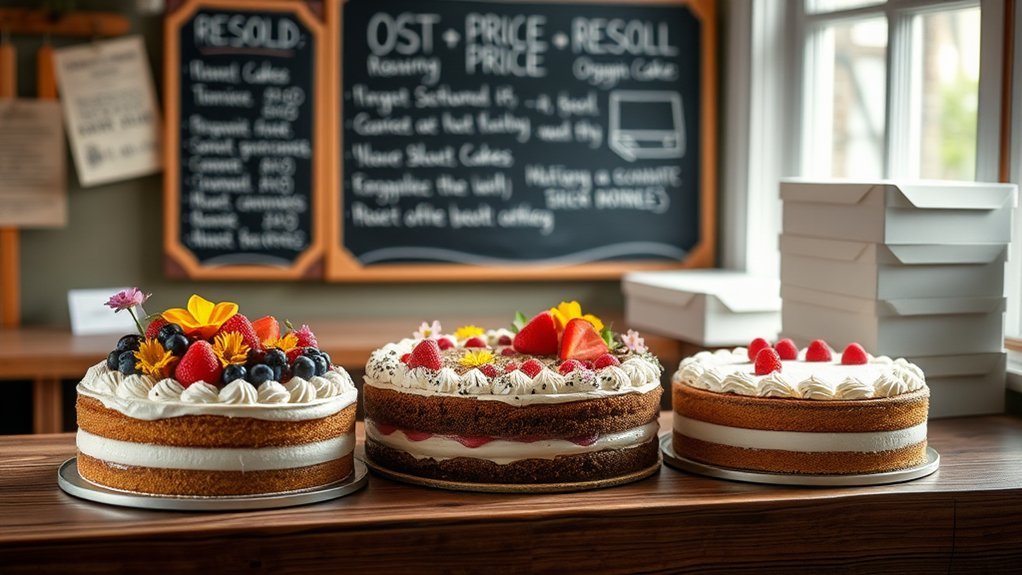
To maximise the reach of your resold organic cakes, it's vital to explore various distribution channels.
Consider partnering with wholesalers and supermarkets, as they dominate the organic bakery market and provide significant access to customers. Additionally, tapping into online retail can greatly expand your reach, especially with the rise of e-commerce.
Don't forget about specialised shops that cater to niche markets; they can help cultivate customer loyalty and boost sales.
Convenience stores also offer a quick purchase option, even though their selection might be limited.
Monitoring Economic Factors and Adjusting Pricing Accordingly

Understanding the economic landscape is crucial for pricing your resold organic cakes, as fluctuations can significantly impact consumer behaviour and demand.
To navigate this effectively, keep an eye on key economic indicators and consumer sentiment:
- Monitor inflation rates to adjust production costs and final prices accordingly.
- Assess supply and demand trends to anticipate changes in ingredient prices.
- Track seasonal demand patterns to optimise your pricing strategy throughout the year.
- Stay informed about competitor pricing and shifts in the market.
Frequently Asked Questions
How Do I Calculate the Profit Margin for My Organic Cakes?
To calculate your profit margin, start by analysing your costs. List all your expenses, such as ingredients, packaging, and overheads. Then, use this formula: subtract your total costs from your total revenue, divide the result by your total revenue, and multiply by 100 to get your profit margin as a percentage.
For example, if you sell a cake for £30 and your total costs are £20, your profit margin would be calculated as follows: (£30 – £20) ÷ £30 x 100 = 33.3%. This means you keep a third of the sale price as profit.
What Are Some Effective Ways to Promote Organic Cakes Online?
To promote your organic cakes online effectively, utilise social media and influencer marketing. Share captivating content, run engaging competitions, and encourage customers to share their own experiences. This will help foster a loyal community around your brand. For instance, consider hosting a 'best cake photo' contest where followers can submit their own pictures for a chance to win a free cake.
How Can I Determine the Right Price Point for a New Product?
To find the right price for your new product, start by conducting market research to assess customer demand. Next, analyse your competitors to understand their pricing strategies. For example, if you're launching a new coffee blend, check out how similar products are priced in local shops. This approach ensures your pricing meets market expectations and remains competitive.
What Role Do Customer Reviews Play in Pricing Strategy?
Customer reviews influence your pricing strategy significantly, much like a sculptor shaping stone. They offer essential feedback that helps you adjust prices to match perceived value, build customer trust, and ultimately boost your business's success and profitability.
For instance, if customers consistently mention that a product is of high quality but priced too low, you might consider increasing the price to better reflect its value. Conversely, if reviews highlight issues with a product, it might be wise to lower the price or enhance its features. This way, customer feedback directly informs your pricing decisions, ensuring they resonate with your audience and support your bottom line.
How Can I Effectively Manage Inventory for Organic Cake Sales?
To effectively manage your inventory for organic cake sales, use accurate inventory tracking methods and implement stock rotation practices. This ensures your ingredients remain fresh, minimises waste, and maximises your profitability. For example, always use older stock first to prevent spoilage. By keeping a close eye on your stock levels and ordering timely, you can maintain a steady supply without overstocking.
Conclusion
Pricing resold organic cakes is crucial for maximising profit. To do this effectively, you need to understand your costs, current market trends, and what customers are willing to pay. For instance, if your ingredients are premium, reflect that in your pricing. A well-thought-out pricing strategy can elevate your business just like a cake rises with the right ingredients.
Keep an eye on economic factors, such as fluctuations in ingredient costs or competition in your area. For example, if a local competitor lowers their prices, consider whether you can justify maintaining yours based on the quality and sustainability of your cakes. This approach not only boosts profits but also helps cultivate a loyal customer base that appreciates the value of organic products.







